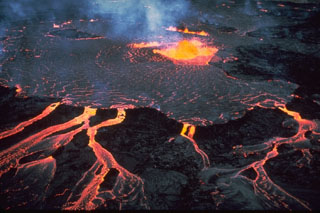Report on Kilauea (United States) — 16 April-22 April 2025
Smithsonian Institution / US Geological Survey
Weekly Volcanic Activity Report, 16 April-22 April 2025
Managing Editor: Sally Sennert.
Please cite this report as:
Global Volcanism Program, 2025. Report on Kilauea (United States) (Sennert, S, ed.). Weekly Volcanic Activity Report, 16 April-22 April 2025. Smithsonian Institution and US Geological Survey.
Kilauea
United States
19.421°N, 155.287°W; summit elev. 1222 m
All times are local (unless otherwise noted)
The Hawaiian Volcano Observatory (HVO) reported that the eruption within Kilauea’s Kaluapele summit caldera, from two vents along the SW margin of Halema’uma’u Crater, continued at variable levels during 16-22 April. Both the N and S vents were strongly incandescent and produced gas emissions on 16 April. Later that evening at around 2110 incandescence at the N vent intensified and began to eject spatter at intervals of 10-20 seconds. Spatter bursts increased in size and frequency, and at around 2130 dome fountains 3-5 m high had formed. A lava pond in the crater rose and was visible at 2145, and by 2201 lava overflowed the crater and traveled short distances (up to 100 m) on the crater floor. Sulfur dioxide emissions were elevated. The activity ceased at 2321. Incandescence from the S vent disappeared when the N vent overflowed but returned once the flows ceased. Both the N and S vents were strongly incandescent and produced gas emissions during 17-20 April.
At around 0745 on 20 April a narrow lava flow was produced from the S vent. Lava fountaining to 2-3 m began soon after, and by 0915 lava flows had traveled about 1 km across the crater floor. After brief pauses during 0930-0943 and 1030-1050, followed by lava flows being fed by 5-m-high dome fountains. Lava flows and dome fountaining resumed after another break during 1110-1222, and then again ceased at 1244. Small gas-pistoning events occurred every 3-5 minutes and were superimposed upon the longer cycles of activity. Intermittent spattering at the N vent began at around 0130 on 22 April and increased in frequency. Lava overflowed the S vent at 0320, and by 0330 lava fountaining was occurring at both vents. Lava overflowed the N vent at 0347. By 0436 the fountain at the S vent was over 200 m high and the N vent fountain was more than 50 m high, feeding lava flows that cascaded down the vent flanks and onto the crater floor. Lava fountains at the N vent slightly grew through the day, rising as high as 60 m. The activity abruptly ceased at 1328, after lava had covered about 30 percent of the crater floor. The Volcano Alert Level remained at Watch (the third level on a four-level scale) and the Aviation Color Code remained at Orange (the third color on a four-color scale).
Geological Summary. Kilauea overlaps the E flank of the massive Mauna Loa shield volcano in the island of Hawaii. Eruptions are prominent in Polynesian legends; written documentation since 1820 records frequent summit and flank lava flow eruptions interspersed with periods of long-term lava lake activity at Halemaumau crater in the summit caldera until 1924. The 3 x 5 km caldera was formed in several stages about 1,500 years ago and during the 18th century; eruptions have also originated from the lengthy East and Southwest rift zones, which extend to the ocean in both directions. About 90% of the surface of the basaltic shield volcano is formed of lava flows less than about 1,100 years old; 70% of the surface is younger than 600 years. The long-term eruption from the East rift zone between 1983 and 2018 produced lava flows covering more than 100 km2, destroyed hundreds of houses, and added new coastline.
Source: US Geological Survey Hawaiian Volcano Observatory (HVO)

